Semifinalists
We are happy to announce that 25 entrants have advanced to the Semifinalist round (Stage Two) of this year’s competition. Semifinalists are now invited to submit a 2500-word Essay based on their 500-word Proposal. At least five, but potentially more top Essays will be selected for final judging by this year’s Berkeley Prize Jury. All authors, whether promoted to Semifinalist status or not, can login to view the reviewers comments regarding your proposals. Find a link to new instructions for this year’s Semifinalists at the bottom of the page. 2022 SEMIFINALISTS
|
| Tushita Basak |
Jadavpur University |
India |
| Dhruv Bhatia and Srishti Grover |
School of planning & Architecture, Bhopal and |
India |
| Anna Blair and Cian Rowan |
University of Limerick |
Ireland |
| Ipsita Choudhury |
School of Planning and Architecture, Bhopal |
India |
|
Beatriz da Costa Gotoda |
University of São Paulo | Brazil |
| Ayesha de Sousa and Andrew de Sousa |
Goa College of Architecture and St. Xavier's College, Mumbai |
India |
| Amalia Dewi Ardianingsih |
Technische Universität Berlin |
Germany |
| Mahmoud El Kady and Tia Ashraf Aziz |
The American University in Cairo |
Egypt |
| Aisha Frampton-Clerk |
Queensborough Community College |
UK |
| Hadiya Javed and Swaleha Javed |
NED University of Engineering and Technology and Bahria University |
Pakistan |
| Mulwana Joel |
Makerere University |
Uganda |
| Aqsa Kanwal |
Indus Valley School of Art and Architecture |
Pakistan |
| Samriddhi Khare and Jiya Anand |
Visvesvaraya National Institute of Technology, Nagpur and Kamala Nehru College |
India |
| Janvi Mangukiya |
Balwant Sheth School of Architecture (BSSA), NMIMS |
India |
| Victoria Masagbor and Elizabeth Masagbor |
University of Benin and University of Ibadan |
Nigeria |
| Nowshin Matin |
Military Institute of Science and Technology |
Bangladesh |
| Aleksandra Mostovaja and Christina Stolz |
The Royal Danish Academy of Arts and Copenhagen Business University |
Denmark |
| Maryanne Muthoni |
Jomo Kenyatta University of Agriculture and Technology |
Kenya |
| Anushka Nagle and Aasavari Thakar |
MKSSS Dr Bhanuben Nanavati College of Architecture and Fergusson College |
India |
| Oprah Omeka |
Jomo Kenyatta University of Agriculture and Technology |
Kenya |
| Upasana Patgiri and Devraj Kumar |
School of Planning and Architecture, Bhopal and Zakir Husain Delhi College, University of Delhi |
India |
| Nafeel Qureshi |
University of Karachi |
Pakistan |
| Sanidhya Shah |
Padmabhushan Vasantdada Patil College of Architecture |
India |
| Yuqi Shao and Rongzhi Hu |
Illinois Institute of Technology and Vassar College |
USA |
| Adila Tahsin Sara and Saidul Islam Shad |
Bangladesh University of Engineering and Technology and University of Dhaka |
Bangladesh |
See Semifinalist instructions here
Additional Help and Information
Are you in need of assistance? Please email info@berkeleyprize.org.|
Elli Mosayebi, Edelaar Mosayebi Inderbitzin Architects (BP2022 Juror): vacancy – no vacancy project. "Floor Plan." (See Essay Question: Introductions by jurors.) 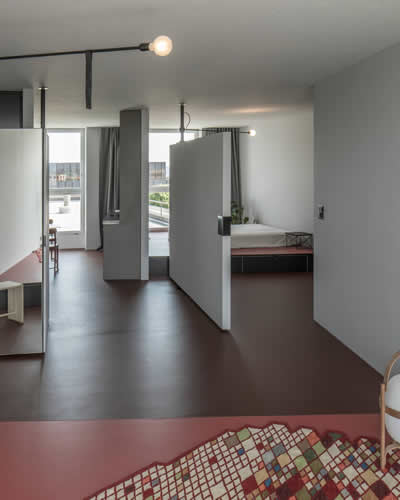 Elli Mosayebi, Edelaar Mosayebi Inderbitzin Architects (BP2022 Juror): vacancy - no vacancy project. "Sleep on riposa." (See Essay Question: Introductions by jurors.) Photo credit: Michael Stirnemann  Elli Mosayebi, Edelaar Mosayebi Inderbitzin Architects (BP2022 Juror): vacancy – no vacancy project. "The two built-in platforms contain numerous storage compartments for personal belongings." (See Essay Question: Introductions by jurors.) 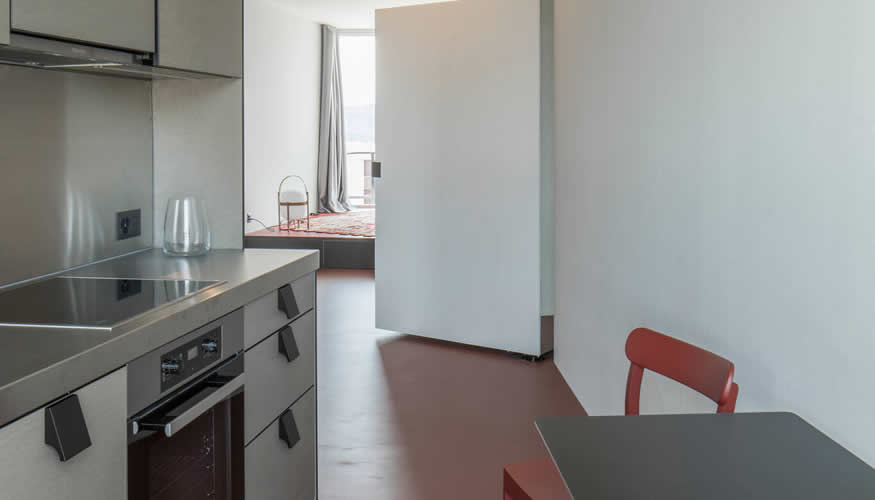 Elli Mosayebi, Edelaar Mosayebi Inderbitzin Architects (BP2022 Juror): vacancy - no vacancy project. "The Kitchen" (See Essay Question: Introductions by jurors.)  Onizuka Crossing Housing, David Baker Architects, San Francisco, 2016. The result of a partnership between MidPen Housing and the City of Sunnyvale, California, U.S.A., Onizuka Crossing provides 58 low-income working families with new, affordable rental homes in Sunnyvale, the heart of the Silicon Valley. Twenty-nine units are reserved for formerly homeless individuals and their families. (See: https://www.dbarchitect.com/project_detail/178/Onizuka%20Crossing%20Family%20Housing.html) Photo credit: ©Bruce Damonte.from DBArchitect.com.  Onizuka Crossing Housing, David Baker Architects, 2016. "Former homeless residents receive extensive supportive services in collaboration with the Santa Clara County Department of Behavioral Health and the U.S. Veterans Administration Palo Alto Healthcare System... Onizuka Crossing is a prime example of infill development, transforming a U.S. National Guard armory building into supportive, permanent affordable housing." (See: https://www.dbarchitect.com/project_detail/178/Onizuka%20Crossing%20Family%20Housing.html) Photo credit: ©Bruce Damonte from DBArchitect.com. 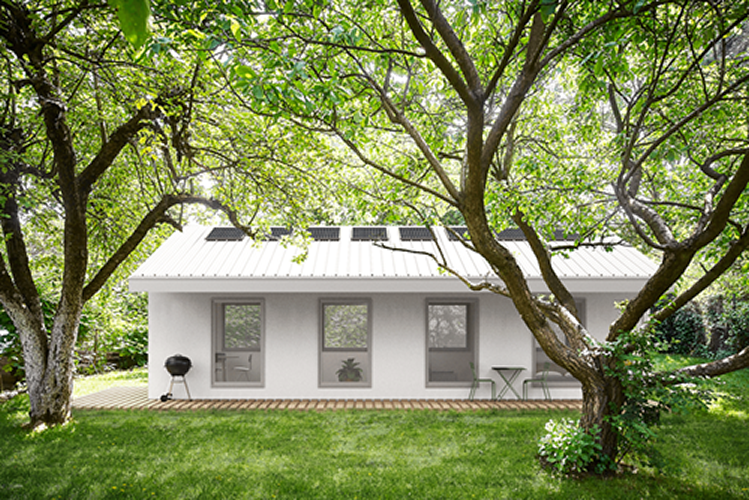 Aleksis Bertoni, Architect, Type Five (BP2022 Juror): Flexible housing adpated over time. Isometric interior perspective of one example. (See Essay Question: Introductions by jurors.)  Aleksis Bertoni, Architect, Type Five (BP2022 Juror). Flexible housing adapted over time. Kitchen rendering of one example. (See Essay Question: Introductions by jurors.) 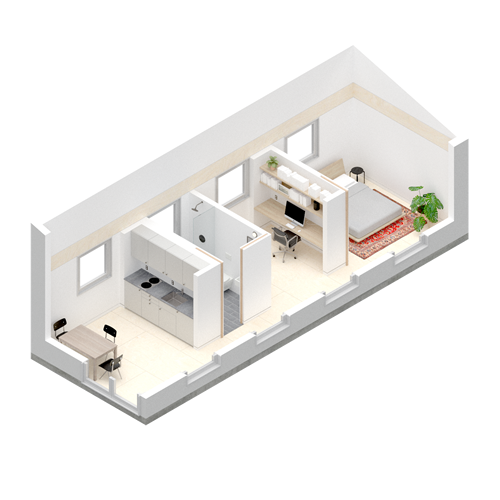 Aleksis Bertoni, Architect, Type Five (BP2022 Juror): Flexible housing adpated over time. Isometric interior perspective of one example. (See Essay Question: Introductions by jurors.)  Aleksis Bertoni, Architect, Type Five (BP2022 Juror). Flexible housing adapted over time. Bedroom rendering of one example. (See Essay Question: Introductions by jurors.) 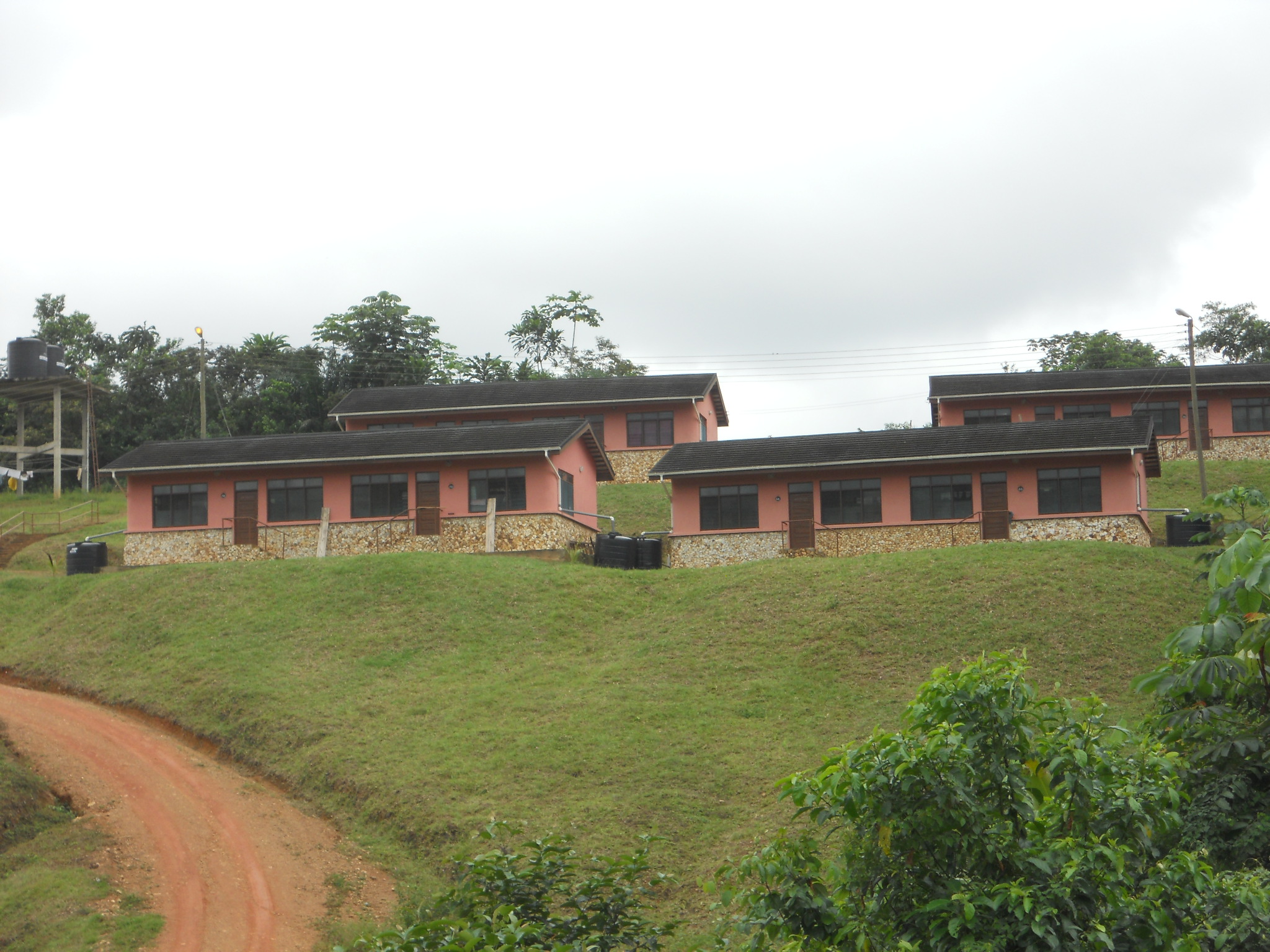 S. Tetteh + Associates Architects, Accra, Ghana. Low-cost housing project for rangers and conservation staff at the Bia and Ankasa Reserves, Juabeso-Bia district, southwest Ghana. 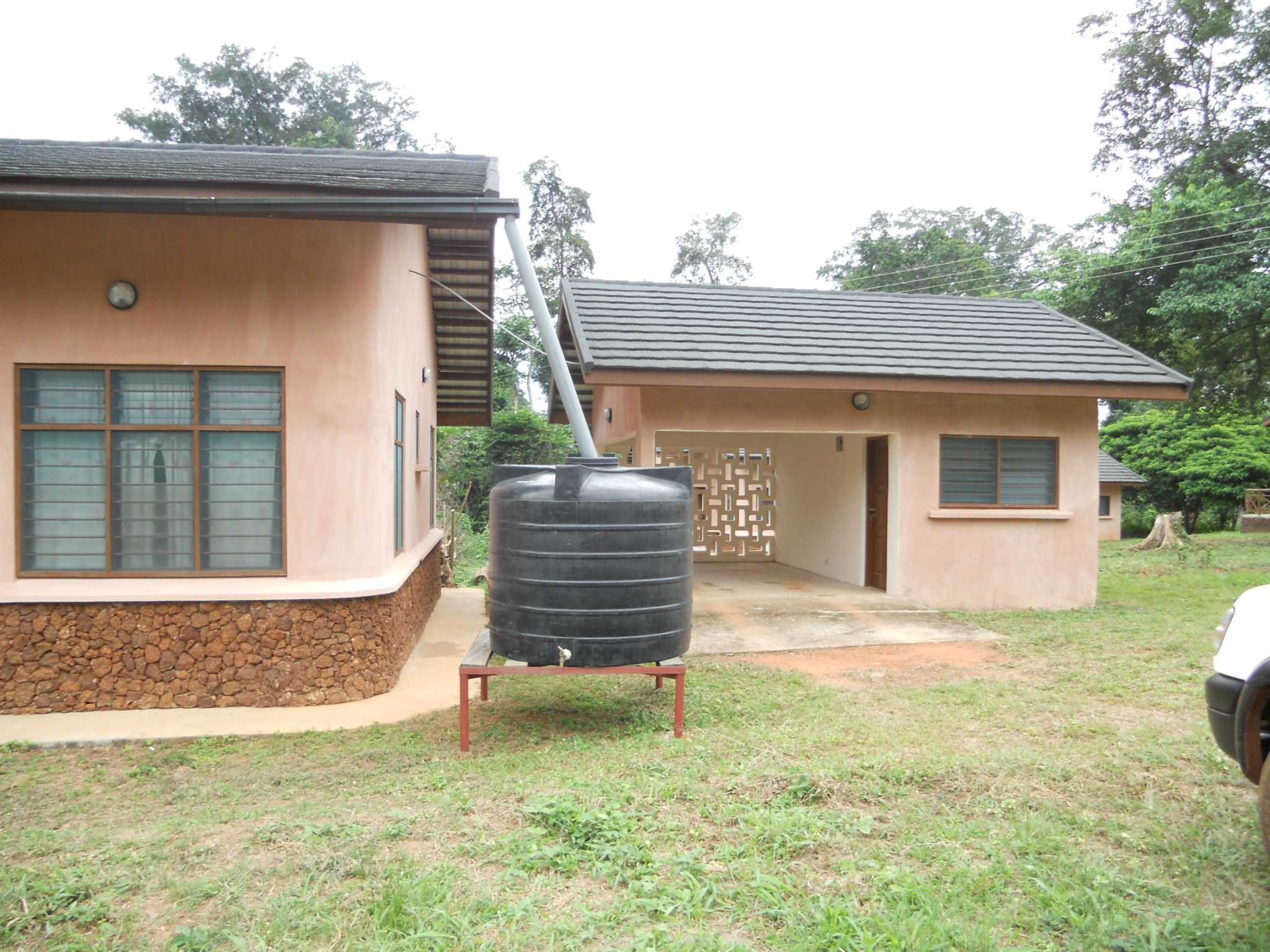 S. Tetteh + Associates Architects, Accra, Ghana. Low-cost housing project for rangers and conservation staff at the Bia and Ankasa Reserves, Juabeso-Bia district, southwest Ghana.  Fondazione Housing Sociale, Milan, Italy: The Housing Foundation developed a class to help future residents form a collaborative community in their housing development. Research by Dorit Fromm, Writer, Architect, BP2022 Juror: (See Essay Question: Introductions by jurors.)  From the manual "Starting Up Communities, A Design Kit for Collaborative Housing," Fondazione Housing Sociale, Milan, Italy. Research by Dorit Fromm, Author, Architect, BP2022 Juror: (See Essay Question: Introductions by jurors.) 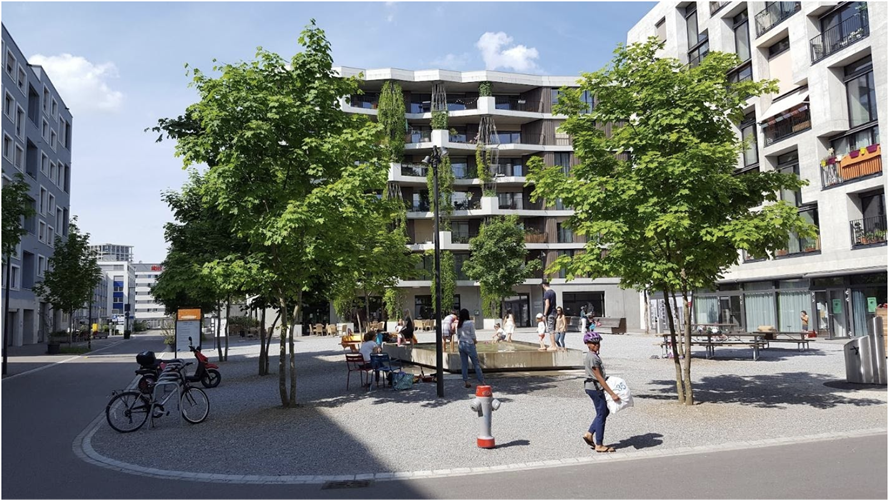 Mehr als Wohnen, Switzerland: A plaza allows neighbors to mingle and is open to the larger neighborhood. Research by Dorit Fromm, Author, Architect, BP2022 Juror: (See Essay Question: Introductions by jurors.)  Mehr als Wohnen, Switzerland: Childcare and afterschool care are located on the ground floor level of the housing, as well as a café and other neighborhood services. Research by Dorit Fromm, Author, Architect, BP2022 Juror: (See Essay Question: Introductions by jurors.) 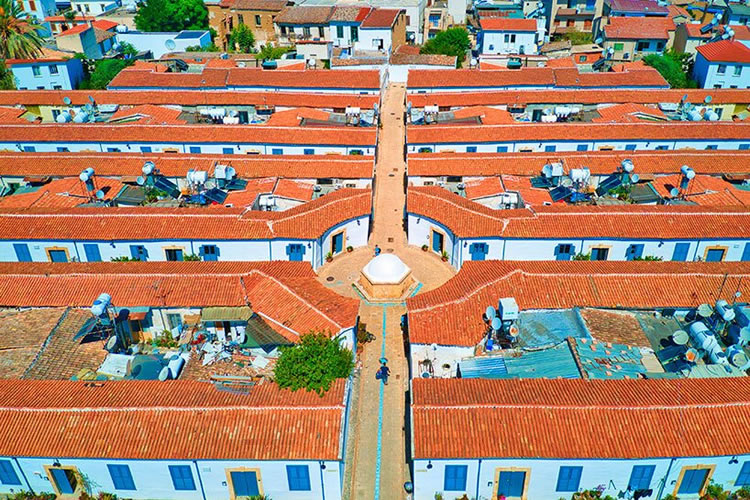 Samanbahce, Nicosia, North Cyprus. A mid-20th century social housing experiment. Drone-view. (See: https://www.designboom.com/architecture/alp-galip-captures-cyprus-first-social-housing-complex-samanbahce-07-17-2021) (Photo by Alp Galip for Designboom.com)  Augustine Owusu-Ansah, S. Tetteh + Associates Architects (BP2022 Juror): Shelter Afrique's 5000 for 5000 Affordable Housing Competition winning entry. (See Essay Question: Introductions by jurors.) 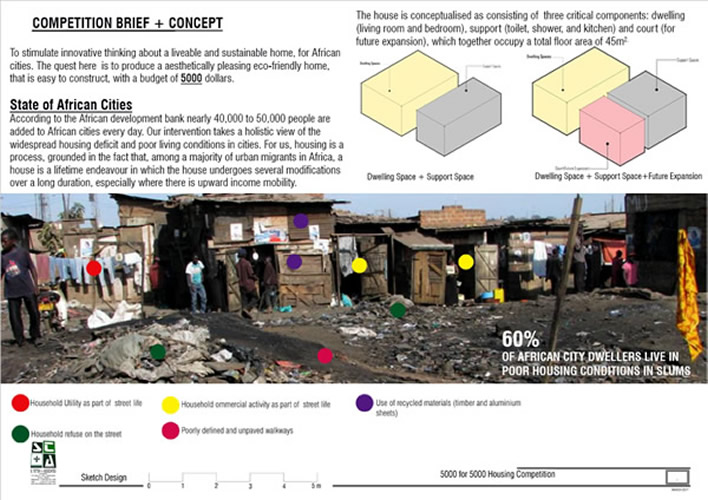 Augustine Owusu-Ansah, S. Tetteh + Associates Architects (BP2022 Juror): Shelter Afrique's 5000 for 5000 Affordable Housing Competition winning entry. (See Essay Question: Introductions by jurors.) 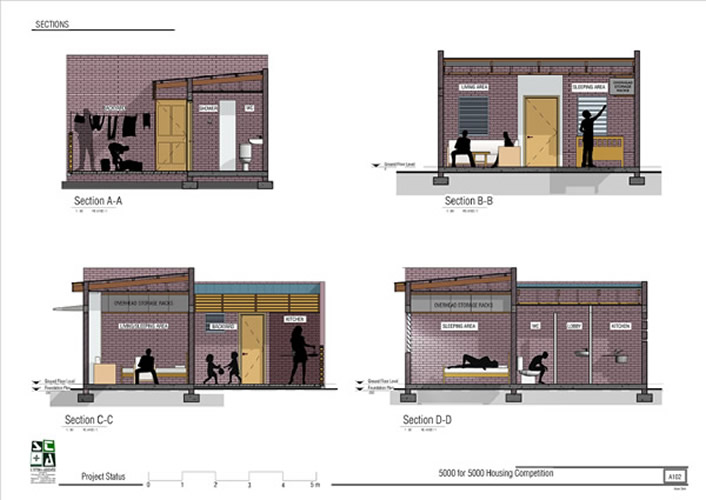 Augustine Owusu-Ansah, S. Tetteh + Associates Architects (BP2022 Juror): Shelter Afrique's 5000 for 5000 Affordable Housing Competition winning entry. (See Essay Question: Introductions by jurors.)  Augustine Owusu-Ansah, S. Tetteh + Associates Architects (BP2022 Juror): Shelter Afrique's 5000 for 5000 Affordable Housing Competition winning entry. (See Essay Question: Introductions by jurors.) 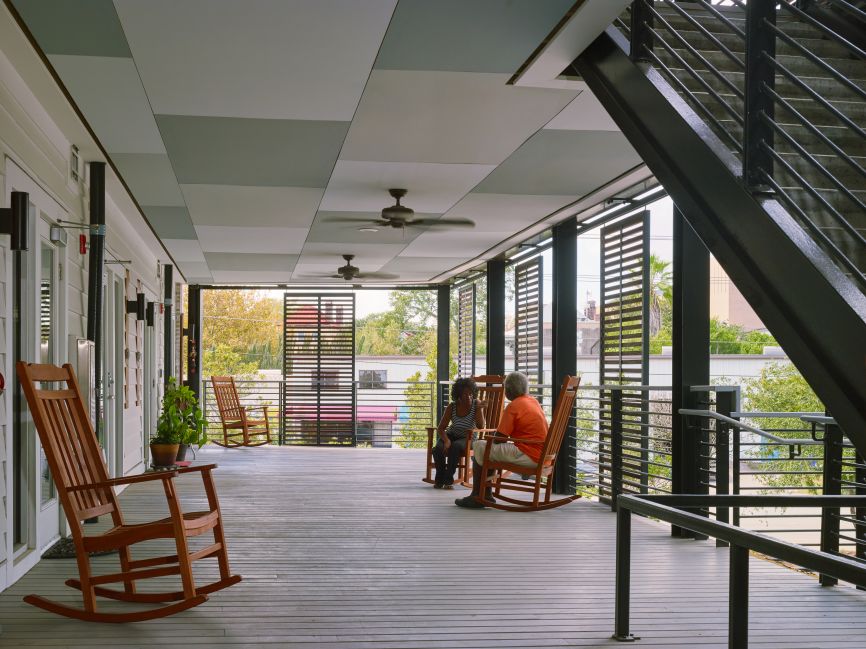 Williams Terrace, Charleston, South Carolina, U.S.A., Architect of Record, McMillan Pazdan Smith Architecture, Spartanburg, South Carolina, U.S.A. /Design Architect, David Baker Architect, San Francisco, California, U.S.A., 2017. "Williams Terrace won the 2019 American Institute of Architects/Housing and Urban Development Secretary's Housing and Community Design Award for Excellence in Affordable Housing Design. This singular nation-wide award recognizes architecture that demonstrates overall excellence in terms of design in response to both the needs and constraints of affordable housing... Wide porches that double as circulation offer places to sit, meet in passing, and personalize a bit of outdoor space." (See: https://www.dbarchitect.com/project_detail/176/Williams%20Terrace%20.html) Photo credit: Chris Luker from DBArchitect.com.  Williams Terrace, Charleston, South Carolina, U.S.A., Architect of Record, McMillan Pazdan Smith Architecture, Spartanburg, South Carolina, U.S.A. /Design Architect, David Baker Architect, San Francisco, California, U.S.A., 2017. "The design team worked closely with the Housing Authority of the City of Charleston to create a dynamic building that meets the challenges of the site—located in a high-velocity flood zone—and respects the gracious built fabric of downtown historic Charleston... Apartments connect to the wide circulation porches, which have room for some personal touches." (See: https://www.dbarchitect.com/project_detail/176/Williams%20Terrace%20.html) Photo credit: Chris Luker from DBArchitect.com. 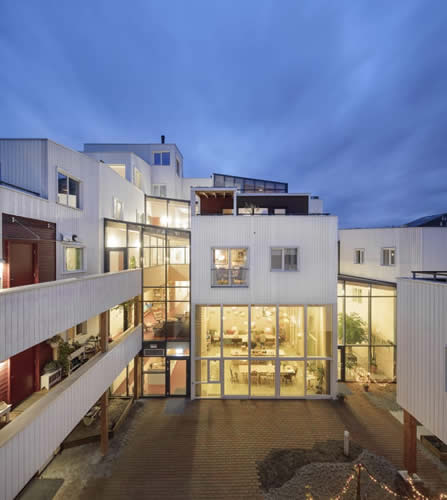 Vindmøllebakken, 40-unit cohousing project, Stavanger, Norway, 2019. Designed by founding architects Siv Helene Stangeland and Reinhard Kropf of Norwegian firm Helen & Hard. The architects now live in Vindmøllebakken. Photo credit: Minna Soujoki Langbord/Courtesy of Helen & Hard via Editon.CNN.com 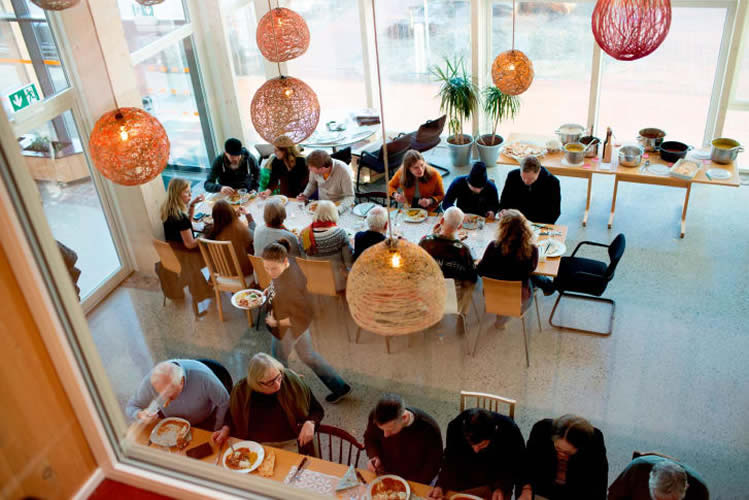 Vindmøllebakken, 40-unit cohousing project, Stavanger, Norway, 2019. In addition to Vindmøllebakken (see previous slide), Helen & Hard are reported to having five other cohousing projects in the works. Photo credit: Sindre Ellingsen/Courtesy of Helen & Hard via Edition.CNN.com  Easter Hill Village, Richmond, U.S.A., 1954. Demolished, 2004. "It was the most significant public effort to provide affordable permanent housing for many families displaced by demolition of temporary World War II housing. It was the first multi-unit residential development to combine the twin themes of the planned unit development with the individuation of units... and the care given to integrating a multi-unit residential development to its site." Historic American Buildings Survey, Library of Congress, U.S.A. (See: https://www.loc.gov/item/ca3350/) 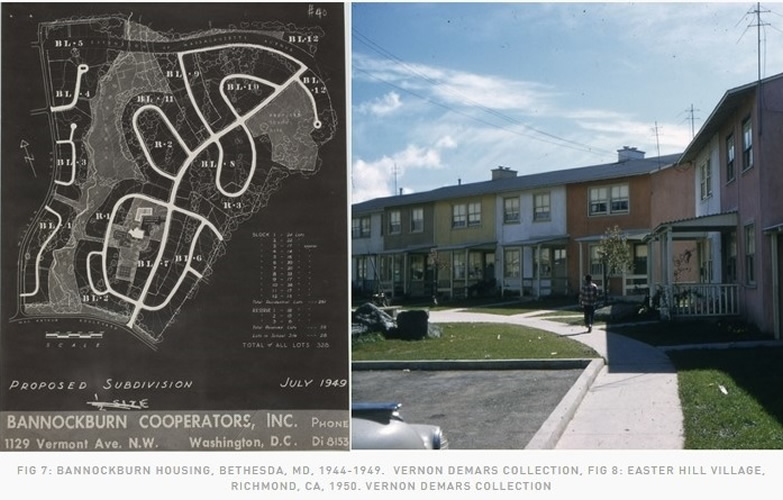 Richmond Village (formerly Easter Hill Village - see previous slide), California, U.S.A., 2008. "The goal for the …Richmond Village project was to turn 300 units of crime-ridden, run-down public housing into a vital neighborhood anchored by a community center and public open space. The development was originally built in 1954 and was a model of public housing until neglect, crime and poverty took over. The Richmond Housing Authority together with Richmond Village…residents collaborated to re-construct a vision of community. The vision included open/community space with mixed-income housing; 100% of the rental housing is affordable, with 70% allocated for public housing residents. The for-sale family homes have a mix of low, moderate and market-rate housing." (See: https://www.nibbi.com/projects/richmond-village/) |
